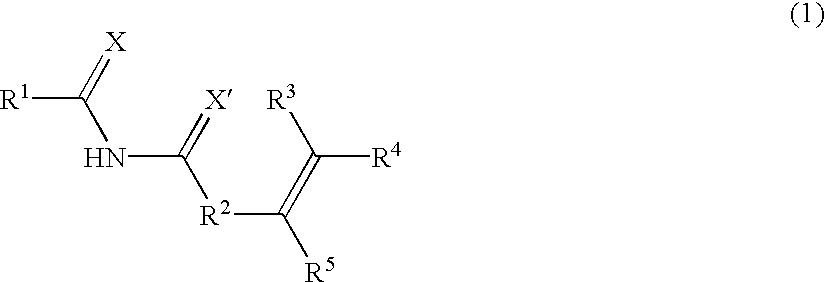Stimuli-responsive polymer utilizing keto-enol tautomerization and stimuli-responsive separating material and chemical-releasing capsule comprising the same
- Summary
- Abstract
- Description
- Claims
- Application Information
AI Technical Summary
Benefits of technology
Problems solved by technology
Method used
Image
Examples
synthesis example 1-1
Synthesis of N-acetyl methacrylamide:
10 ml of methacroyl isocyanate was dissolved in 50 ml of THF in a flask. To the solution was then added dropwise 35 ml of a 3 mol / l THF solution of methyl magnesium bromide at a temperature of −20° C. in an atmosphere of nitrogen. After the termination of the dropwise addition, the mixture was then stirred at room temperature for 1 hour. To the mixture were then added 100 ml of a 2 N hydrochloric acid and 100 ml of ethyl acetate sequentially. The resulting organic phase was then washed twice with saturated brine. The solvent was then distilled off under reduced pressure. The residue thus obtained was then recrystallized from ethyl acetate to obtain 5.3 g of a colorless crystal (yield: 48%). NMR analysis gave a strong indication that the product is the desired compound.
synthesis example 1-2
Synthesis of N-benzoyl methacrylamide:
2 ml of methacroyl isocyanate was dissolved in 20 ml of THF in a flask. To the solution was then added dropwise a 3 mol / l THF solution of phenyl lithium at a temperature of −20° C. in an atmosphere of nitrogen. After the termination of the dropwise addition, the mixture was then stirred at room temperature for 1 hour. To the mixture were then added 100 ml of a 2 N hydrochloric acid and 100 ml of ethyl acetate sequentially. The resulting organic phase was then washed twice with saturated brine. The solvent was then distilled off under reduced pressure. The residue thus obtained was then recrystallized from ethyl acetate to obtain 1.3 g of a colorless crystal (yield: 40%).
NMR analysis gave a strong indication that the product is the desired compound.
synthesis example 1-3
Synthesis of other N-acyl(meth)acrylamide Derivatives:
The isocyanates represented by general formula (9) and the organic metal compound represented by general formula (10) set forth in the table below were reacted in the same manner as in Synthesis Example 1-1. As a result, the desired compound (11) was obtained in a yield set forth in the table below.
TABLE 1Compound of general formula (10)Compound ofEthylPropylgeneral formulaPhenylmagnesiummagnesium(9)lithiumbromidebromideAcroyl isocyanate55%45%43%Methacroyl51%47%44%isocyanate
In accordance with the above described production process of the present invention, an N-acyl(meth)acrylamide derivative which can be used as a monomer for a stimuli-responsive polymer or modifier or as a starting material of herbicide can be simply synthesized in a good yield.
Another production process is described below.
That is, an N-acyl(meth)acrylamide derivative can be simply produced by reacting:
an amide represented by the following general formula (12):...
PUM
| Property | Measurement | Unit |
|---|---|---|
| Percent by mass | aaaaa | aaaaa |
| Critical solution temperature | aaaaa | aaaaa |
| Weight | aaaaa | aaaaa |
Abstract
Description
Claims
Application Information
 Login to View More
Login to View More - Generate Ideas
- Intellectual Property
- Life Sciences
- Materials
- Tech Scout
- Unparalleled Data Quality
- Higher Quality Content
- 60% Fewer Hallucinations
Browse by: Latest US Patents, China's latest patents, Technical Efficacy Thesaurus, Application Domain, Technology Topic, Popular Technical Reports.
© 2025 PatSnap. All rights reserved.Legal|Privacy policy|Modern Slavery Act Transparency Statement|Sitemap|About US| Contact US: help@patsnap.com



